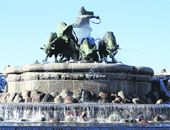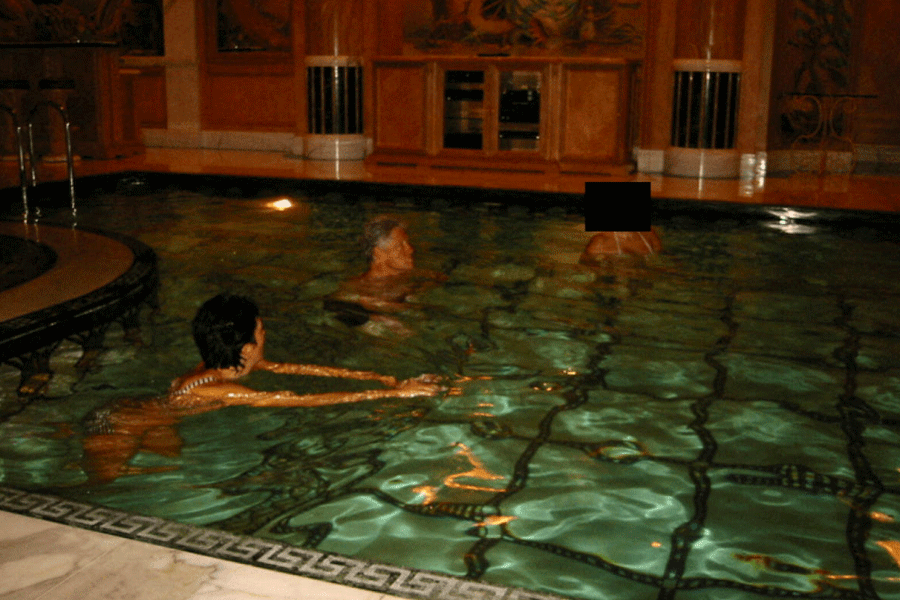 |
The official party ended a few months ago. But the hangover remains all over Copenhagen. April 2, 2005 was the 200th birth anniversary of Denmark’s most famous storyteller Hans Christian Andersen, and it was the start of a yearlong celebration for the Danes, who went into a commemorative frenzy. Long after the party, the mark still remains on coins, stamps, statues, friezes and other memorabilia.
There were signs of it even in our hotel room — the beautifully located Comfort Hotel. On our bedside was a book that had nine classics from Andersen’s enormous repertoire along with a biographical note. So, we quickly leafed through the tale of the Little Mermaid since that statue is the iconic symbol of Copenhagen.
We decided to begin our journey into Andersen’s fairy tale land with Amalienborg Palace, Queen Margrethe II’s residence, which was just two minutes away. At noon everyday, the change of guards takes place, and after a heavy brunch, we headed there.
The Amalienborg Palace was a place that Andersen — who in his own words blossomed from an unwanted Ugly Duckling to a sought after swan — frequented as the guest of King Christian IX, who ruled Denmark between 1863 and 1906. The museum in the apartments of the late king are a great attraction for tourists.
 |
The kids didn’t want to stay indoors, and watched with delight as the guards marched in wearing their ridiculous bear hats and black uniforms (they wear red only on big occasions like the Queen’s birthday).
The square of Amaliehaven, where the block of four palaces is located with an equestrian statue in the middle, a fountain on one side with the harbour behind it and an impressive Romanesque church opposite, makes for a stirring sight. In this setting, put the marching guards who look a bit like toy soldiers. Not surprisingly, we dawdled here quite a bit, before making our way to the green domed Frederiks Church, or Marmorkirken.
This church was built to rival St. Peter’s in Rome and has one of the largest domes in Europe. We found it useful over the next few days because we’d look out for the green dome to find our way back to the hotel.
From the church, we wound our way down the street towards Kongens Nytorv (The King’s New Square) stopping to buy ice-creams and Viking helmets for the kids. But it took us a while to reach the end of the road as the shops and art gallery windows — with their range of paintings, ceramics, furniture, artifacts, fabrics — were just too beguiling.
Eventually, we did get to the square, a very happening area. A wildlife photography exhibition was on in the middle of the square. To one side was Nyhaven, the picturesque harbour street with pavement cafes, restaurants and bars, while traditional yachts and Viking boats were anchored in the inlet beside. The guide book said Andersen lived on this street.
 |
Tempting though the cheery street with the 17th century gabled apartments looked, we turned towards Kongens Have (The Kings Garden), the oldest park in Denmark, where the storyteller is said to have found inspiration for many a tale.
As we entered the park, it seemed the whole of Copenhagen had that idea — every inch of the greens was taken up by blond-haired sun-bathers, their bikes sprawled besides their glistening bodies, books and picnic meals open. Children and dogs frolicked about.
While some of us opted to snooze under a tree, the others headed to find Andersen’s statue. Kongens Have was laid out when Christian IV commissioned the Rosenborg Castle in 1634. The park is dotted with sculptures — we guessed these were probably installed when it was re-landscaped in the 19th century according to English ideals. However, remnants of the original Renaissance garden and the Baroque influences of the 18th century do remain.
Andersen’s statue portrays a cloaked man, sitting in a chair, arm outstretched as though reading to an invisible audience. Apparently, the storyteller and the sculptor had differences over how the statue should look — the sculptor wanted to place a small listening child leaning against one of his legs, to which Andersen objected saying his tales were as much for adults as for children. Besides, Andersen was much more than a fairy tale writer as the Danes will testify. Although he had his way, he didn’t live long enough to see it.
By now we were dead tired and headed back to the hotel for a long rest. In the evening, we headed towards the harbour to see the Little Mermaid, cutting through the lovely natural grounds in Churchillparken. It was a pleasant stroll through the woods with swans in the lake, an English church (St Albans) in the background and statues that reminded us of wood nymphs and other mythical creatures. A bridge over a moat led to a 17th century citadel (Kastellet), which we explored later.
 |
En route was also the huge Gefion Fountain, which depicts the story of how Zealand (the island on which Copenhagen is situated) came into existence. The story goes that Gefion was given permission by the Swedish King Gylfe to plough an area in Sweden. The land she ploughed within one day and one night would be hers. So, she turned her four sons into oxen and managed to get the earth needed to create Zealand.
On we went along the pretty harbour road, cheered by the riot of flowers along the path, until we spotted the rock on which the Little Mermaid sat. At first glance, it was disappointingly tiny. But get closer and the 93-year old mermaid’s charms become apparent. Set on a rock by the sea, so that she would always be wet like a real mermaid, the statue was brewer Carl Jacobsen’s (of Carlsberg breweries fame) gift to the city.
There are loads of other Andersen associations in Copenhagen as we found out in subsequent days. The overpriced, garishly lit, kitschy amusement park of Tivoli Gardens was the inspiration behind The Nightingale. The Round Tower, which not only gives a fantastic view but houses astronomical treasures, was mentioned in Andersen’s The Tinderbox.
For those not interested in fairy tales or Andersen, there’s the “Hygge” side of Copenhagen (have fun, relax, enjoy the weather, get into a good mood) to explore. A trip to the Carlsberg breweries is recommended as is a trip to the free city of Christiana — the hippie village. And, of course, going across the engineering marvel that the Oresmund bridge is, half under and half over the sea, into Malmo, a modern Swedish city — but that’s another story.
Photographs by author











